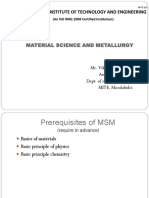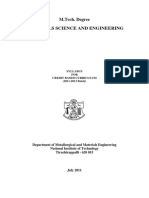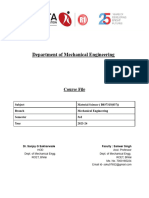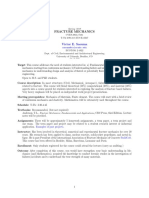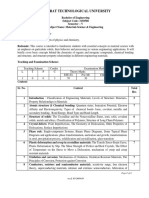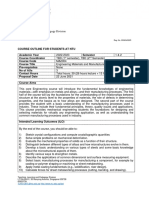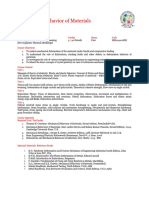MET311E Physical Metallurgy
MET311E Physical Metallurgy
Uploaded by
Saúl L Hdez TCopyright:
Available Formats
MET311E Physical Metallurgy
MET311E Physical Metallurgy
Uploaded by
Saúl L Hdez TOriginal Description:
Copyright
Available Formats
Share this document
Did you find this document useful?
Is this content inappropriate?
Copyright:
Available Formats
MET311E Physical Metallurgy
MET311E Physical Metallurgy
Uploaded by
Saúl L Hdez TCopyright:
Available Formats
ISTANBUL TECHNICAL UNIVERSITY FACULTY OF CHEMICAL & METALLURGICAL ENGINEERING
DEPARTMENT OF METALLURGICAL AND MATERIALS ENGINEERING
T
SELF STUDY REPORT APPENDIX A COURSE SYLLABUS
Course Name
Physical Metallurgy
Course Implementation, Hours/Week
Code
Semester
Local Credits
MET311E
5
Department/Program
Course Type
Required
Course Prerequisites
Met 221E min FF
Course Category
by Content, %
Basic Sciences
Course Description
Course Objectives
Course Learning
Outcomes
Textbook
Other References
Homework & Projects
Laboratory Work
Computer Use
ECTS Credits
3
5
Metallurgical and Materials Engineering
Theoretical
3
Course Language
Tutorial
-
Laboratory
-
English
Engineering Science Engineering Design
General Education
80 %
20 %
This course aims to introduce a theoretical basis for understanding how structure is controlled by means of
providing a link between various transformations taking place in materials and the resulting microstructural
and physical properties. For this reason, it is a mandatory course for the three options of the Metallurgical
and Materials Engineering department.
1. To introduce the field of Physical Metallurgy and some related applications; to provide
phenomenological explanations for plastic deformation, dislocations and dislocation interactions and
their contributions to the slip mechanism.
2. To explain qualitatively vacancy formation in crystalline materials; concept of diffusion and various
diffusion mechanisms in crystals; the importance of interface concept and their classification, dihedral
angle and final microstructure relations.
3. To explain the phenomena of nucleation and solidification by using Arrhenius type equations and to
demonstrate, in detail, the thermodynamic and kinetic aspects of phase transformations on the
structure of materials.
4. To describe the morphologies of the phases during phase transformations (nucleation, crystal growth,
solidification and precipitation mechanisms and the effect of deformation on recovery, recrystallization
and grain growth.
5. To describe the Fe-C phase diagram and the TTT diagrams for steels and describe the pearlite,
austenite, bainite and martensite phases and to design suitable heat treatment procedures for
annealing, tempering and solutionizing and to predict the age hardening behavior of an alloy on the
basis of its phase diagram and composition.
6.
To provide information on diffusionless transformations, shape memory alloys: the Ni-Ti and other
example systems and its martensitic reactions. To motivate students for continuous learning about
Special Topics in Materials Science related to Physical Metallurgy using their basic knowledge gained
during the course.
1. To understand the field of Physical Metallurgy and learn phenomenological explanations related to
dislocations and dislocation interactions and their contributions to the slip mechanism during plastic
deformation; and be able to calculate the critical shear stress and most favored slip directions in
different lattices to comprehend the concept of the critical resolved shear stress and Schmid factor.
2. To learn the vacancy formation in crystalline materials; concept of diffusion and various diffusion
mechanisms in crystals; the importance of interface concept and its classification, dihedral angle and
final microstructure relations and to be able to solve the problems related to first and second Ficks law
and new phase formation during diffusion.
3. To understand the phenomena of nucleation and solidification by using Arrhenius type equations and
thermodynamic and kinetic aspects of phase transformations on the structure of materials.
4. To understand how the different phase morphologies occur during phase transformations (nucleation,
crystal growth, solidification and mechanisms precipitation);learn the effect of deformation on recovery,
recrystallization and grain growth and differentiates their morphologies.
5. To learn Fe-C phase diagram and TTT diagrams for steels and to describe the pearlite, austenite,
bainite and martensite phases and to be able to design suitable heat treatment cycles and post
treatment (annealing, tempering) to yield final desired properties.
6. To predict the possibility of age hardening behavior of an alloy on the basis of its phase diagram and
composition. To learn diffusionless transformations, Shape memory effect and the alloys having this
behavior: the Ni-Ti and other example systems and its martensitic reactions.
- John D. Verhoeven, "Fundamentals of Physical Metallurgy", John Wiley & Sons, New York, 1974.
- Robert E. Reed-Hill, "Physical Metallurgy Principles", Brooks/Cole Engineering Division, Monterey, CA,
1973.
-William F. Hosford, Physical Metallurgy, Taylor & Francis, 2005
There is an optional term project under the theme Special Topics in Physical Metallurgy provided
that the number of students enrolled in course do not exceed 25.
none
Other Activities
Assessment Criteria
Activities
Quantity
Effects on Grading, %
Midterm Exams
MIN 1
25-30
Quizzes
MIN 4
16-30 *
Homework
Projects
Term Paper/Project
MAX 1
0-14 *
Laboratory Work
Other Activities
Final Exam
1
40-45
* Total percentage of quizzes and term project grades should not exceed 30 %.
** This is an optional project based on the decision of the lecturer if the total number of students enrolled in
the course do not exceed 25.
APPENDIX A DEPARTMENT COURSES 16
ISTANBUL TECHNICAL UNIVERSITY FACULTY OF CHEMICAL & METALLURGICAL ENGINEERING
DEPARTMENT OF METALLURGICAL AND MATERIALS ENGINEERING
T
SELF STUDY REPORT APPENDIX A COURSE SYLLABUS
COURSE PLAN
Weeks
1
2
3
4
5
6
7
8
9
10
11
12
13
14
Topics
Introduction to Physical Metallurgy and some related applications
The plastic deformation of metal crystals. (1) Slip systems. CRSS, Single Crystal and Polycrystalline
deformation.
The plastic deformation of metal crystals (2) Dislocations: edge, screw dislocation and mixed dislocations ,
Energy of dislocations
Vacancies. Vacancy formation and related kinetic relations, Interfaces. Surface energy, Coherent
Boundaries and Dihedral angle
st
nd
Diffusion. (1) Ficks 1 and 2 laws, Phenomological and atomistic approaches, Temperature and time
dependence of diffusion coefficient, Interstitial and Substitutional Diffusion, Kirkendall effect, Matano
Interface.
Diffusion (2) Carburization and decarburization of steel. Self diffusion in pure Metals, Interdiffusion between
phases, behavior of two phase regions during diffusion. Surface, grain-boundary and bulk diffusion
Kinetics of nucleation. Homogeneous and heterogeneous nucleation. Growth kinetics
Solidification of pure metals and alloys. Equilibrium and non-equilibrium freezing equations. Eutectic and
peritectic solidification. Cast metals. Dendritic solidification. Cast structures. Metallic Glasses
Recovery and recrystallization. The stored energy during deformation. Physical properties of during
recovery and recrystallization. Kinetics of recovery and recrystallization Grain growth during annealing - I
Recovery and recrystallization The stored energy during deformation. Physical properties of during
recovery and recrystallization. Kinetics of recovery and recrystallization Grain growth during annealing -II
The Fe-C binary system. The transformation of austenite to pearlite. Pearlite, ferrite and cementite phases.
The effect of temperature on phase transformations. TTT curves, Bainite and Martensite formation- I
The Fe-C binary system. The transformation of austenite to pearlite. Pearlite, ferrite and cementite phases.
The effect of temperature on phase transformations. TTT curves, Bainite and Martensite formation- II
Annealing. Precipitation from solid solutions. Nucleations in the solid solutions. Preferred crystallographic
orientationDiffusionless Transformations, Shape memory alloys: the Ni-Ti and other example systems and its
martensitic reactions.
Course
Outcomes
I
I
I
II
II
II
III
III
IV
IV
V
V
VI
VI
Relationship between the Course and the Metallurgical and Materials Engineering Curriculum
Level of Contribution
Program Outcomes
Ability to apply the knowledge of mathematics, science and engineering principles to solve
problems in metallurgical and materials engineering (ABET:a)
2
Ability to characterize materials using standard and/or self designed experimental methods and
to evaluate the results (ABET:b)
3
Ability to design a system or a process, taking into consideration of the desired specifications,
quality, ethics and environment. (ABET:c)
4
Ability to communicate both orally and in the written form and to take part in, and provide
leadership of the teams in the elucidation of engineering problems; (ABET:d, g)
5
Ability to define, formulate and solve engineering problems in the development, production,
processing, protection and usage of engineering materials. (ABET:e)
6
An understanding of professional and ethical responsibilities(ABET:f)
7
An understanding of current/contemporary issues and impact of engineering solutions in broad
cultural, national and global levels;. (ABET:h, j)
8
A comprehension of the nature of engineering progress closely linked with the development of
new materials and production processes. An ability to engage in life-long learning and a
recognition of its necessity (ABET:i)
9
Ability to use essential tools and techniques of modern engineering in the development,
production, processing, protecting and surface treatment of the existing and new engineering
materials. (ABET:k)
1: Little, 2. Partial, 3. Full
Course relationships with major elements of the field and material classes
Date
X
X
X
X
Level of Contribution
1
2
3
X
X
X
X
X
X
X
X
STRUCTURE
PROPERTIES
DESIGN EXPERIMENT/ANALYSE DATA
MAJOR ELEMENT OF THE FIELDS PROCESSING
COST/PERFORMANCE
QUALITY/ENVIRONMENT
DESIGN PROCESS OR PRODUCT
METAL
CERAMICS
MATERIAL CLASSES
POLYMERS
COMPOSITES
1: Little, 2. Partial, 3. Full
Prepared by
PROF.DR. LTF VEOLU
YRD. DR. BURAK ZKAL
Signature
20.12.2009
APPENDIX A DEPARTMENT COURSES 17
You might also like
- Fundamentals of Ceramics CO PDFDocument2 pagesFundamentals of Ceramics CO PDFAbrham HaileNo ratings yet
- Defects and Defect Processes in Nonmetallic SolidsFrom EverandDefects and Defect Processes in Nonmetallic SolidsRating: 4 out of 5 stars4/5 (1)
- Power SystemDocument26 pagesPower Systemanandvmahadik50% (2)
- Me6501 Mechanical Behaviour of MaterialsDocument54 pagesMe6501 Mechanical Behaviour of MaterialsSiddarthanSrtNo ratings yet
- Mangalore Institute of Technology and Engineering: Material Science and MetallurgyDocument203 pagesMangalore Institute of Technology and Engineering: Material Science and MetallurgyNISHAANTH S 1861462No ratings yet
- AM Material ScienceDocument4 pagesAM Material ScienceTushar Mani AgarwalNo ratings yet
- aea0341c-48ee-4db6-ab82-2f315ea06091Document3 pagesaea0341c-48ee-4db6-ab82-2f315ea06091gongigon1321No ratings yet
- Material Science and Metallurgy PDFDocument1 pageMaterial Science and Metallurgy PDFSanjay GomastaNo ratings yet
- Me209 Mechanical Properties of Structural Materials PDFDocument4 pagesMe209 Mechanical Properties of Structural Materials PDFjishnuNo ratings yet
- Material Science EngineDocument5 pagesMaterial Science EngineJohn_AdaNo ratings yet
- TK 0?usp SharingDocument3 pagesTK 0?usp SharingETHIO GamingNo ratings yet
- Materials Sceince and TechnologyDocument18 pagesMaterials Sceince and TechnologyRajareddyDuddekuntaNo ratings yet
- 1 THDocument2 pages1 THAditya TNo ratings yet
- PDFDocument50 pagesPDFMichael FurlanettiNo ratings yet
- Testing and Modelling of Material Behaviour and Formability in Sheet Metal - FormingDocument23 pagesTesting and Modelling of Material Behaviour and Formability in Sheet Metal - Formingnitouch3564No ratings yet
- Material Science and Metallurgy PDFDocument1 pageMaterial Science and Metallurgy PDFGopi KrishnaNo ratings yet
- Mtech Mme Materials Science 2012 13Document19 pagesMtech Mme Materials Science 2012 13Anonymous sENwj8nwqNo ratings yet
- 3rd and 4th Sem Syllabus-MMEDocument16 pages3rd and 4th Sem Syllabus-MMENaman AgrawalNo ratings yet
- Syllabus 3rd SemDocument6 pagesSyllabus 3rd Sem083Rahul SinghNo ratings yet
- MSE PG CoursesDocument65 pagesMSE PG CoursesMirtunjay KumarNo ratings yet
- IISC Bangalore - Materials Engineering Courses-2013-14Document8 pagesIISC Bangalore - Materials Engineering Courses-2013-14Sri PuduNo ratings yet
- Semester III - FALL 2014 Details of Courses: From Individuals To Ecosystems. Blackwell PublishingDocument8 pagesSemester III - FALL 2014 Details of Courses: From Individuals To Ecosystems. Blackwell Publishingvmad2100No ratings yet
- BPKM - Technology of Microstructural Analysis 2018Document22 pagesBPKM - Technology of Microstructural Analysis 2018Muhammad ThohariNo ratings yet
- Material Science SyllabusDocument2 pagesMaterial Science Syllabus1DA20ME023 Girish M BNo ratings yet
- Mechanical Metallurgy PDFDocument646 pagesMechanical Metallurgy PDFDeepak Ashokan80% (5)
- Metallurgical and Materials Engineering: M.Tech. ProgramsDocument17 pagesMetallurgical and Materials Engineering: M.Tech. ProgramsSachith Praminda RupasingheNo ratings yet
- Emt 2132 Introduction To Material Science PDFDocument52 pagesEmt 2132 Introduction To Material Science PDFStephanie MirañyiNo ratings yet
- Course Work Material ScienceDocument29 pagesCourse Work Material ScienceSameer SinghNo ratings yet
- B. Tech. in Metallurgical & Materials Engineering VNITDocument29 pagesB. Tech. in Metallurgical & Materials Engineering VNITShameekaNo ratings yet
- OutlineDocument6 pagesOutlineAnant RamdialNo ratings yet
- Bmee209l Materials-science-And-Engineering TH 1.0 67 Bmee209lDocument3 pagesBmee209l Materials-science-And-Engineering TH 1.0 67 Bmee209lKrijayNo ratings yet
- Mme 312 AssignmentDocument5 pagesMme 312 AssignmentFaruqNo ratings yet
- 3rd Sem Course DiaryDocument61 pages3rd Sem Course DiaryShafiq Ahmed ShahbazNo ratings yet
- MukeshDocument22 pagesMukeshVikram NikhilNo ratings yet
- FM Course OutlineDocument4 pagesFM Course Outlinev rajuNo ratings yet
- List of QuestionsDocument2 pagesList of Questionstripathi522003No ratings yet
- Materials Science and Engineering Course OutlineDocument17 pagesMaterials Science and Engineering Course OutlineKathryn SantosNo ratings yet
- MMS Course FileDocument22 pagesMMS Course Filejohn_raju17No ratings yet
- Damage Mechanics in Metal Forming: Advanced Modeling and Numerical SimulationFrom EverandDamage Mechanics in Metal Forming: Advanced Modeling and Numerical SimulationRating: 4 out of 5 stars4/5 (1)
- Gujarat Technological University: W.E.F. AY 2018-19Document3 pagesGujarat Technological University: W.E.F. AY 2018-19Pradeep SutharNo ratings yet
- Chemistry: Courtesy: Waec Uploaded byDocument41 pagesChemistry: Courtesy: Waec Uploaded byAkpevweoghene Kelvin IdogunNo ratings yet
- Condensed Couse OutlinesDocument7 pagesCondensed Couse OutlinesnaolmenderaNo ratings yet
- Jrefrmpum Ajy? Jrefrmuasm? RSDK Cspfpdwf"Gwf&Sifoef Xufjrufa& Pmay? Bmompum ? A (Kokwzwfpm AvhusifhpmDocument7 pagesJrefrmpum Ajy? Jrefrmuasm? RSDK Cspfpdwf"Gwf&Sifoef Xufjrufa& Pmay? Bmompum ? A (Kokwzwfpm AvhusifhpmAyush TiwariNo ratings yet
- Advanced Program in Material Science and EngineeringDocument9 pagesAdvanced Program in Material Science and Engineeringmai4ka-1No ratings yet
- MA2004 Engineering Materials and Manufacturing Processes 23082021Document7 pagesMA2004 Engineering Materials and Manufacturing Processes 23082021Aloysius TobiasNo ratings yet
- Punjab Technical University: Scheme & Syllabus of B. Tech. 1 & 2 Semester Batch-2011Document42 pagesPunjab Technical University: Scheme & Syllabus of B. Tech. 1 & 2 Semester Batch-2011Pankaj SainiNo ratings yet
- National University of Engineering College of Geological, Mining and Metallurgical Engineering Metallurgical Engineering ProgramDocument3 pagesNational University of Engineering College of Geological, Mining and Metallurgical Engineering Metallurgical Engineering ProgramRiswan RiswanNo ratings yet
- Solid MechanicsDocument2 pagesSolid MechanicsAbhishek ShuvoNo ratings yet
- EAS203Document2 pagesEAS203lsk7424No ratings yet
- Syallabus PH 8251 Material ScienceDocument2 pagesSyallabus PH 8251 Material ScienceAkhil KumarNo ratings yet
- BTECH Syllabus-1Document31 pagesBTECH Syllabus-1AJIT PRASAD 12- C. Roll-04No ratings yet
- Materials Science Course Outline: Text BooksDocument3 pagesMaterials Science Course Outline: Text BooksABDELRHMAN ALINo ratings yet
- Applied Physics-I: Faculty of Technology & Engineering First Semester of B. E. I (Textile) (Tech)Document20 pagesApplied Physics-I: Faculty of Technology & Engineering First Semester of B. E. I (Textile) (Tech)Vivek ParmarNo ratings yet
- MCESC Structural Engineering and Construction ManagementDocument23 pagesMCESC Structural Engineering and Construction ManagementsonofalexanderNo ratings yet
- Materia Engineering Cha 1Document236 pagesMateria Engineering Cha 1amanuelfitsum589No ratings yet
- B.Sc.-VI SeDocument2 pagesB.Sc.-VI SeAryan SinghalNo ratings yet
- MRS Symposium U: Bulk Metallic Glasses and Their ApplicationsDocument1 pageMRS Symposium U: Bulk Metallic Glasses and Their ApplicationsDerek WebsterNo ratings yet
- 4th Semester SyllabusDocument8 pages4th Semester Syllabus006KAbhishek KumarNo ratings yet
- Chemistry Outline For Refresher Course UpdatedDocument5 pagesChemistry Outline For Refresher Course Updatedabhisheksingh89208No ratings yet
- Programing Manual TDocument534 pagesPrograming Manual TSaúl L Hdez TNo ratings yet
- 'LVHXR / Phglflyq GH Ilowurv DqdoyjlfrvDocument27 pages'LVHXR / Phglflyq GH Ilowurv DqdoyjlfrvSaúl L Hdez TNo ratings yet
- 316 316L 317L Spec Sheet PDFDocument3 pages316 316L 317L Spec Sheet PDFSaúl L Hdez TNo ratings yet
- ENGG2012 A&B Advanced Engineering Mathematics Solution 5: Tutor: Xixuan WuDocument6 pagesENGG2012 A&B Advanced Engineering Mathematics Solution 5: Tutor: Xixuan WuSaúl L Hdez TNo ratings yet
- ENGG2012 A&B Advanced Engineering Mathematics Solution 6: Tutor: Xixuan WuDocument4 pagesENGG2012 A&B Advanced Engineering Mathematics Solution 6: Tutor: Xixuan WuSaúl L Hdez TNo ratings yet
- ENGG2012 A&B Advanced Engineering Mathematics Solution 4: Tutor: Xixuan WuDocument5 pagesENGG2012 A&B Advanced Engineering Mathematics Solution 4: Tutor: Xixuan WuSaúl L Hdez TNo ratings yet
- Mechanical Properties of Metals - IIDocument33 pagesMechanical Properties of Metals - IISaúl L Hdez TNo ratings yet
- Pyranometer Meter SpecsDocument4 pagesPyranometer Meter SpecsSaúl L Hdez TNo ratings yet
- 2012 Catalogue OKU PanelsDocument2 pages2012 Catalogue OKU PanelsSaúl L Hdez TNo ratings yet
- OPTIS WhitePaper 1008 Solar CPCDocument10 pagesOPTIS WhitePaper 1008 Solar CPCSaúl L Hdez TNo ratings yet
- Good Welding Practice Stainless Steels-PresentaciónDocument30 pagesGood Welding Practice Stainless Steels-PresentaciónSaúl L Hdez TNo ratings yet
- Greenroads Rating System: A Blueprint For Building Sustainable Transportation ProjectsDocument4 pagesGreenroads Rating System: A Blueprint For Building Sustainable Transportation ProjectsJanaka KarunarathnaNo ratings yet
- 11 Economics Notes Ch13Document4 pages11 Economics Notes Ch13HackerzillaNo ratings yet
- English Term Paper TopicsDocument6 pagesEnglish Term Paper Topicsfuhukuheseg2100% (2)
- Sedu e 46 2004 - 0 PDFDocument6 pagesSedu e 46 2004 - 0 PDFall is well rajaNo ratings yet
- Johnil Pp.Document13 pagesJohnil Pp.Jestoni BarrientosNo ratings yet
- Algorithm To CHKDocument14 pagesAlgorithm To CHKrajkumar.manjuNo ratings yet
- Altivar 16 ManualDocument33 pagesAltivar 16 Manualpromatis5746100% (1)
- Brick Dimensions: Design Theory NATA - Architecture - Fashion - Management 2243, Sector 28, FaridabadDocument3 pagesBrick Dimensions: Design Theory NATA - Architecture - Fashion - Management 2243, Sector 28, FaridabadjashndeepNo ratings yet
- Op METEODocument1 pageOp METEOBogdanNo ratings yet
- History IDocument15 pagesHistory IANMOL GOELNo ratings yet
- Abbott Diagnostics Architect I1000sr BrochureDocument12 pagesAbbott Diagnostics Architect I1000sr Brochureاكرم امينNo ratings yet
- THE RELEVANCE OF STUDYING HISTORY IN THE 21st CENTURYDocument10 pagesTHE RELEVANCE OF STUDYING HISTORY IN THE 21st CENTURYRagadi ButoNo ratings yet
- Example Term Paper in EconomicsDocument8 pagesExample Term Paper in Economicsc5j2ksrg100% (1)
- PreDefense (201 15 13919)Document18 pagesPreDefense (201 15 13919)Shamim NahidNo ratings yet
- 2013 Melbourne Cup Carnival Access MapsDocument5 pages2013 Melbourne Cup Carnival Access MapsFlemington RacecourseNo ratings yet
- W80 Triplex Pump W375 Quintuplex PumpDocument2 pagesW80 Triplex Pump W375 Quintuplex Pumpadewunmi olufemiNo ratings yet
- Plag - Evaluating The Employee Retention in OrganizationDocument95 pagesPlag - Evaluating The Employee Retention in OrganizationcityNo ratings yet
- Instrumentation and Controls AP1000 Design Control DocumentDocument6 pagesInstrumentation and Controls AP1000 Design Control DocumenthafizgNo ratings yet
- Low Advanced Sentence Completion 2Document6 pagesLow Advanced Sentence Completion 2Luis Martin Mejia [STUDENT]No ratings yet
- Teaching PlanDocument3 pagesTeaching PlanMira ManoharanNo ratings yet
- 10 TPH Palm Oil Production LineDocument52 pages10 TPH Palm Oil Production LineSouleïman CisséNo ratings yet
- US UK Avista PDS Vitec 3000 FinalDocument1 pageUS UK Avista PDS Vitec 3000 FinalEmin MešićNo ratings yet
- GUIDELINE No CA11 COMMUNICATIONDocument21 pagesGUIDELINE No CA11 COMMUNICATIONChina AlemayehouNo ratings yet
- Applied Sciences: Fficiency of Agricultural Tractors ForDocument19 pagesApplied Sciences: Fficiency of Agricultural Tractors For29 - 023 - Abid HasanNo ratings yet
- RPH EXCEL CEFR Bahasa Inggeris Form 1-5Document17 pagesRPH EXCEL CEFR Bahasa Inggeris Form 1-5NOORZATUL IFFAH BINTI BADRUL KHAIRI MoeNo ratings yet
- Review of Shop Drawings - Steel StructuresDocument7 pagesReview of Shop Drawings - Steel Structuresعزت عبد المنعمNo ratings yet
- Acid Base Salts LESSON PLAN For PresentationDocument4 pagesAcid Base Salts LESSON PLAN For PresentationLaxman SdNo ratings yet
- Leadership: Jean B. Ganub, RPHDocument18 pagesLeadership: Jean B. Ganub, RPHJean GanubNo ratings yet
- IMUN Internship - General InformationDocument11 pagesIMUN Internship - General InformationTamim HossenNo ratings yet




